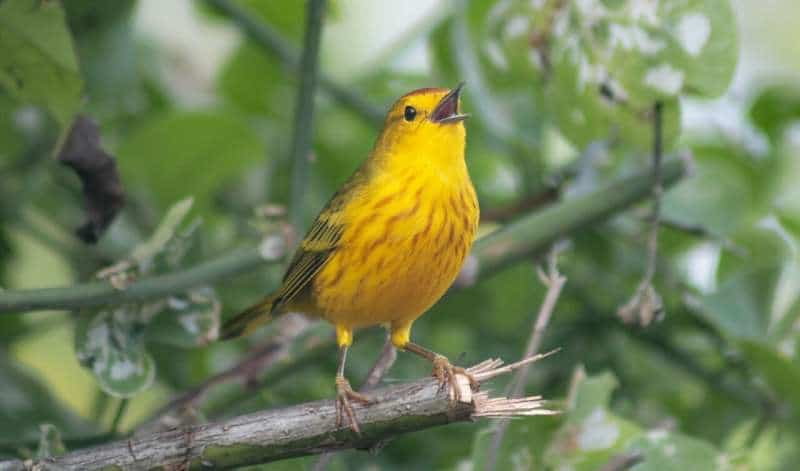This post was originally published on Eco Watch
New research has found that the persistent sound of traffic can aggravate Galápagos yellow warblers and cause them to change their behavior, possibly because they realize their songs may be being drowned out by the noise.
The study was led by experts from Anglia Ruskin University (ARU) and University of Vienna’s Konrad Lorenz Research Centre.
The Galápagos Islands lie more than 500 miles off Ecuador’s coastline and are seen as a “living laboratory” because of the many unique, endemic species who call the archipelago home, a press release from ARU said.
Galápagos yellow warblers are genetically distinct from yellow warblers in the Americas and are classified as a subspecies.
The researchers found that Galápagos yellow warblers living near busy roads behaved more aggressively when recordings of another bird were played alongside traffic sounds. They said this could be due to the birds realizing that their songs, which are effectively warnings to intruders encroaching on their territory, could be being masked by the din of cars and trucks.
“Communication usually is in lieu of physical aggression but, if the communication is not possible because of noise, then they might actually engage in risky behaviours that would lead to a physical fight,” said co-author of the findings Dr. Çağlar Akçay, a behavioral ecologist at ARU, as The Guardian reported.
Since Charles Darwin first visited the Galápagos in 1835, there has been a significant rise in the number of humans living on the islands. The permanent population is growing by more than six percent a year, which means more vehicles on the roads.
“The Galapagos Islands are famous for plant and animal life which has been there for thousands of years before human beings appeared on the islands. As the population of the Islands grow[s], it is important to monitor the impact of the human population on the environment,” according to Galápagos Conservation Trust.
A Galápagos yellow warbler. Alper Yelimlies
The research team played birdsong accompanied by traffic noise from a speaker at 38 locations on the islands of Santa Cruz and Floreana. Twenty of the sites were within approximately 164 feet of the closest road, while 18 were more than 328 feet away.
The team measured the warblers’ songs, as well as aggressive, physical behaviors like coming close to the speaker and flying repeatedly over it.
The researchers observed that the warblers who lived in roadside territories displayed increased aggression, while those living farther away from roads showed less aggression in comparison to trials without noise.
“Birds use song during territorial defence as an aggressive signal. However, if external noise such as traffic interferes with the signalling, effectively blocking this communication channel, increasing physical aggression would be an appropriate response,” Akçay said in the press release.
The “roadside effect” was even apparent on Floreana Island, where there were only around 10 vehicles, suggesting minimal traffic can also impact the noise responses of Galápagos yellow warblers.
“Our results show that the change in aggressive responses in yellow warblers occurred mainly near roads. Birds occupying roadside territories on both islands, and therefore having regular experience of traffic noise, may have learned to increase physical aggression when the territorial intrusion was accompanied by traffic noise,” Akçay said.
During the noise experiments, Galápagos yellow warblers increased their songs’ minimum frequencies regardless of how close their territory was to the road, which helped cut down on the overlap between their songs and the low-frequency traffic noise. Warblers on Santa Cruz, a more populated island, extended the length of their songs when confronted with traffic noise.
“We also found some evidence of birds trying to cope with noise by adjusting their song, with yellow warblers in all habitats increasing the minimum frequency of their songs to help them be heard above the traffic noise,” Akçay added.
The findings support the theory that an individual bird’s experience with noise, or long-term selection in response to noise, allows birds to adapt and adjust aspects of their songs.
“Our study shows the importance of considering behavioural plasticity in conservation efforts and developing strategies to mitigate the effects of noise pollution on wildlife. It also highlights the significant impact of human activities on wildlife behaviour, even in relatively remote locations such as the Galápagos Islands,” Akçay said.
The study, “Galápagos yellow warblers differ in behavioural plasticity in response to traffic noise depending on proximity to road,” was published in the journal Animal Behaviour.
The post Galápagos Yellow Warblers Living Near Traffic Noise Act More Aggressively, Study Finds appeared first on EcoWatch.





0 Comments